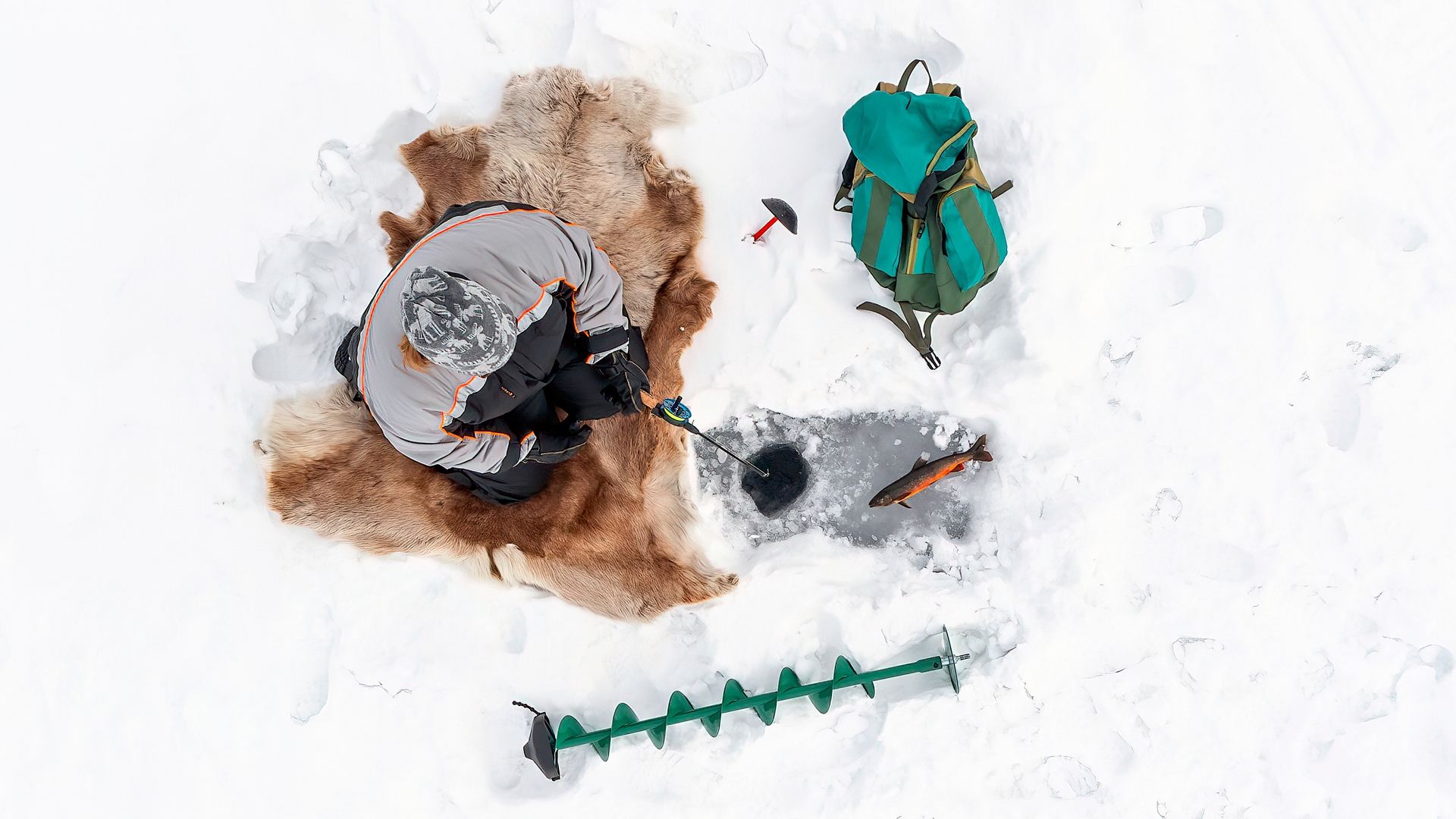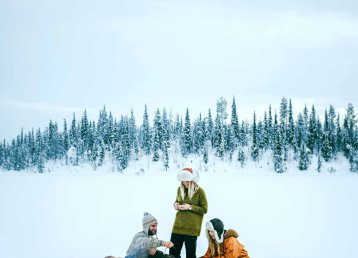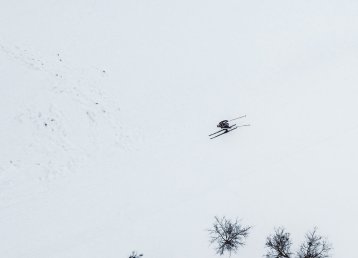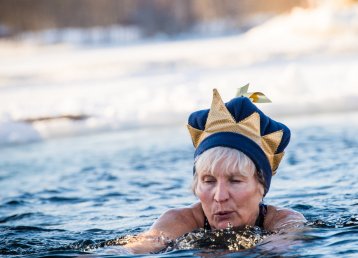Fishing stories
Fishing on ice – whether it be on the first, brittle ice of the season or on the metre-thick ice armour of late winter – appeals to a certain kind of person. To make the fishing trip a story, the catch must be something out of the ordinary and preferably bordering on dangerous. For the story to have potential to become a classic it’s definitely an advantage if the fish is the size of a whale, or if the person attempting to catch it is a character along the lines of captain Ahab.
This doesn’t often happen. In most cases what we’re dealing with is the complete opposite: most fish being caught are ridiculously small and hardly worth mentioning. No one wants to listen to you telling them how you caught Arctic char that would fit comfortably in a sardine tin. So – all fishers are born honest, then most of them get over it. You should just take fishing stories for what they are. Some are actually worth telling, and completely true to boot.
Into the hole
I went to a birthday party for a 60-year-old a while ago. The protagonist’s neighbour was there too, with his arm bandaged up to his bicep. Being of a somewhat cautious nature, I never asked what was hidden underneath the gauze. Instead, I resorted to asking the hostess some discreet questions, suggesting that the neighbour was perhaps burned in a fire. It turned out he’d been out fishing, placing tip-up fishing gear on the ice down by his house. A record-breaking pike decided to go for his bait, and after some initial bother the neighbour managed to get the pike’s head into the hole. That’s where it all came to a halt. The hole was too small, and the pike too fat. The line ended up snapping clean off and he watched the fish slowly sink back down the hole.
“The greediness of pike knows no bounds”
Suddenly, the pike gaped, and the old man’s reaction was to thrust his right fist straight into the mouth of the beast, which triggered an ancient instinct: it bit! The neighbour’s hand was now stuck among millions of slimy teeth. Pikes don’t tend to let go of their prey once they’ve sunk their teeth in, so it kept its mouth shut following the movement upwards and onto the ice. The beast weighed 14,6 kilos and as such worth both the visit to the health centre and the subsequent antibiotics. Back in 1847, Sergey Timofeyevich Aksakov got it right in his classic book Notes on Fishing when he wrote “The greediness of pike knows no bounds”.
Spots of a different colour
Those of us who like fishing in the mountains rarely go there to catch pike, because our minds are focused on fish with spots of a different colour. We’re hoping to meet the Greta Garbo of the mountains: the Arctic char. It’s shy by nature and beautiful to behold, difficult to catch and delicious on the plate. There are several restaurants in the mountains that serve Arctic char these days, but you could also try to cook it yourself.
If you failed to catch one, just buy some locally caught fish and grab the frying pan. Many chefs emphasise that we often kill our fish twice: once when we catch it and then again in the pan, overcooking it. But Arctic char is quite fatty, making failure less likely. It’s actually one of few species of fish in the north that anyone can prepare, so there’s no need to bring your sous vide to the mountain chalet.
The other day I was savouring a lovely Arctic char in a cosy restaurant when a good friend, who is also a marine biologist, told me that if you have two Arctic char, from mountain lakes next to each other but with no connecting water course, they can be as genetically different as a person from the European mainland and someone from Scandinavia. This might be unnecessary or trivial knowledge, but in times of ignorance such as these it might be worth keeping in mind. We all come from somewhere else, even if we’ve ended up next to each other up in the mountains.
Wildlife Photographer Magnus Winbjörk
Wildlife Photographer Magnus Winbjörk capture arctic elements and wildlife in the very North of Sweden. Above the Arctic circle he spend most of his time in the outdoors striving to share his view on the arctic elements.
The arks
The weather is a constant factor. You won’t always be able to unfold a chair and relax, enjoying the added vitamin D being soaked up by your skin. But when it happens, you certainly appreciate it. Travelling by train to Abisko and Riksgränsen, you can see tiny moveable huts – arks – on lake Torneträsk. They are pulled there by snowmobiles, anchored to the ice and function as shelters and somewhere to stay when winter extends its grip on nature. Inside the ark there’s an opening in the floor, and underneath this opening there’s a hole in the ice where you can get water to make some coffee, or perhaps enjoy a spot of fishing.
"That first ice isn’t for those who prefer their hot chocolate without clear additives"
Lots of people have tried ice fishing. They do this in spring, when the smell of coffee and hot chocolate being poured out of flasks permeates the mountains. Lying on a reindeer skin, enjoying the sun and the warmth, this is easy-going recreation and a wonderful time of the year. But to real ice fishers, it’s the first ice of the season that appeals. That’s when you get the best fishing. But the first ice in the mountains is only for a certain type of people. That is, those who are willing to endure a cold that threatens the proverbial brass monkey’s appendages, and those who want to catch a fish so big that the story ends with a visit to the hospital. That first ice isn’t for those who prefer their hot chocolate without clear additives.
“The moronic sport”
I’m staring down into a hole in the ice, and I’ve been at it for a good few hours now. The entire day, in fact. I can’t help wondering what I’m actually doing, even if it’s obvious. The last I felt of my feet, they were frozen; now, they’re not even there. My hands have lost some of their functions too. They feel clumsy, like when you’re slept on them at night. Numb. This is what happens when you’re sat without moving and it’s 16 degrees below zero, blowing hard, snow whirling around you. You freeze, right down to your core.
Lifting my gaze, all I can see is white. I concentrate on the hole in the ice, on the line that disappears under the surface and how water freezes along it, forming lumps. The line twitches every now and then. At least that’s what I hope it’s doing, but it doesn’t happen often. As you may have gathered, ice fishing isn’t an activity for people looking for adrenaline, dopamine, or ‘any-ine’. On the ice, your eyes locked on a dark hole in the ice, you have the entire day to yourself. You also realise why author Jim Harrison called ice fishing “the moronic sport”.
Tranquillity and beauty
A lot has been said about the beauty and allure of the Arctic char, and even more has been said about the landscape it lives in. The tranquillity and beauty of the mountains is a lure in itself, even when your toes are freezing off. Judge John D. Voelker, in fishing literature better known as Robert Traver, might have phrased it best: “I fish because I love to; because I love the environs where [fish] are found, which are invariably beautiful, and hate the environs where crowds of people are found, which are invariably ugly; […] in a world where most men seem to spend their lives doing things they hate, my fishing is at once an endless source of delight and an act of small rebellion […] And, finally, not because I regard fishing as being so terribly important but because I suspect that so many of the other concerns of men are equally unimportant – and not nearly so much fun.” Sometimes it’s as easy as me sat staring down a hole in the ice because it links me to a beautiful world. I don’t have to stare at an Excel sheet here, for example.
Arya in the Arctic
On the day Arya Gonzales was born, in Barcelona, Spain, it snowed! You can call it a sign to why you nowadays will find her, way up in the Arctic, mushing her beloved huskies.
Uncomplicated activities
Ice fishing isn’t the most complicated of pursuits. You find ice that will hold your weight, drill a hole, let your hook drop into the water and you’re off. The first ice is called kernel ice and will hold some 80 kilos when it’s four centimetres thick. In my case I made sure it was more than six centimetres thick before I ventured out on the lake. Sometimes you have to watch the margins, and just to be on the safe side my fishing equipment includes ice safety picks. Also, when it comes to ice fishing, some are more successful than others. They might have better technique, better knowledge, and a better kit, or perhaps it’s as simple as them being better at being lucky.
"Perhaps it’s as simple as them being better at being lucky"
Ice fishing is an activity. I normally engage in activities because it makes me hungry, or rather: because it eases my conscience when I’m hungry yet again. But staring down a hole and freezing your behind off isn’t very active, I hear you say. True, very true. But drilling a hole, many holes, is an activity. When the winter ice is a metre thick and consists of kernel ice, rotten ice, ‘water-on-top-of-the-ice’ and snow, you don’t have to drill many holes to deserve an extra helping at dinner.
Look up
Speaking of all these holes, it’s worth remembering you don’t have to ask experts or the staff at the tourist office where the best fishing is. Just look up. Where there are plenty of holes drilled, or where many people have gathered on the ice, that’s where the fish are and where you should drill your holes to catch some. But if you prefer fishing in solitude there will be a cove somewhere on the lake where no holes are drilled. Keep in mind that new holes are always better than old, if not else because it will keep your appetite up.































